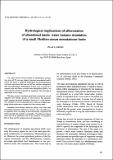Por favor, use este identificador para citar o enlazar a este item:
http://hdl.handle.net/10261/6778COMPARTIR / EXPORTAR:
 SHARE
BASE SHARE
BASE
|
|
| Visualizar otros formatos: MARC | Dublin Core | RDF | ORE | MODS | METS | DIDL | DATACITE | |

| Campo DC | Valor | Lengua/Idioma |
|---|---|---|
| dc.contributor.author | Llorens, Pilar | - |
| dc.date.accessioned | 2008-08-19T12:07:10Z | - |
| dc.date.available | 2008-08-19T12:07:10Z | - |
| dc.date.issued | 1993 | - |
| dc.identifier.citation | Acta Geológica Hispánica, v. 28 (1993), $2-3, p. 131-138 | en_US |
| dc.identifier.issn | 1695-6133 | - |
| dc.identifier.uri | http://hdl.handle.net/10261/6778 | - |
| dc.description | 1 am especially indebted to F. Gallart for his critica1 revision of the manuscript that greatly irnproved it. 1 am also very grateful to P. Biron and J. Latron for their comments.5 | en_US |
| dc.description.abstract | The intense human activity suffered by Mediterranean mountainous areas ti11 50 years ago induced important geoecological modifications that played a significant hydrological and geomorphological role during agricultural land use and still have relevant consequences after land abandonment. Reforestation of these areas is perceived to suppose in the next future a senous water management problem, but more research is needed to quantify the magnitude of the hydrological implications of this change. This paper presents a simulation model made to analyze the role that vegetation cover changes can play on water resowces. This simulation model compares the actual hydrological behaviour of a small mountainous catchment covered by grassland with its behaviour modeled considering that the whole area is covered by a Pinus sylvestris stand. Simulation results during a sensitivity analysis, with forest water consumption parameters taken from literature, show that differences in vegetation cover can modify al1 the water balance components but effect especially both quickfiow and baseflow. The differences depend much more on the parameters used for the simulation of interception than on those used for stomatal control of transpiration. | en_US |
| dc.description.sponsorship | This work has been funded by an agreement between the CSIC and ICONA (LUCDEME research program or Fight Against the Desertification of the Mediterranean). Author contribution was possible thanks to a MECMRT postdoctoral fellowship and subsequently, a MEC research contract. | en_US |
| dc.format.extent | 586394 bytes | - |
| dc.format.mimetype | application/pdf | - |
| dc.language.iso | eng | en_US |
| dc.publisher | CSIC - Instituto de Ciencias de la Tierra Jaume Almera (ICTJA) | en_US |
| dc.rights | openAccess | en_US |
| dc.subject | Hidrología | en_US |
| dc.subject | Balance hidrológico | en_US |
| dc.subject | Cuenca mediterránea | en_US |
| dc.subject | Simulación | en_US |
| dc.title | Hydrological implications of afforestation of abandoned lands: water balance simulation of a small Mediterranean mountainous basin | en_US |
| dc.type | artículo | en_US |
| dc.description.peerreviewed | Peer reviewed | en_US |
| dc.type.coar | http://purl.org/coar/resource_type/c_6501 | es_ES |
| item.openairecristype | http://purl.org/coar/resource_type/c_18cf | - |
| item.fulltext | With Fulltext | - |
| item.cerifentitytype | Publications | - |
| item.openairetype | artículo | - |
| item.languageiso639-1 | en | - |
| item.grantfulltext | open | - |
| Aparece en las colecciones: | (Geo3Bcn) Artículos | |
Ficheros en este ítem:
| Fichero | Descripción | Tamaño | Formato | |
|---|---|---|---|---|
| 98264.pdf | 572,65 kB | Adobe PDF |  Visualizar/Abrir |
CORE Recommender
Page view(s)
242
checked on 18-abr-2024
Download(s)
139
checked on 18-abr-2024
Google ScholarTM
Check
NOTA: Los ítems de Digital.CSIC están protegidos por copyright, con todos los derechos reservados, a menos que se indique lo contrario.
